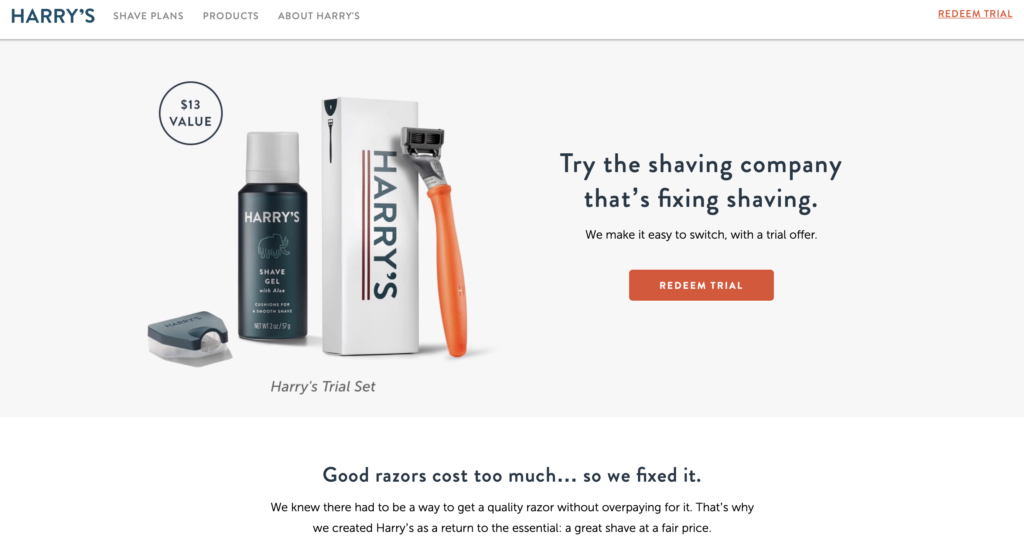Sometimes, brands are lucky enough to come up with a new spin on a product that’s so significant they don’t have trouble making a name for themselves. Others, however, are forced to break into an industry with so many big, established names for simple products that it’s hard to set themselves apart and keep their businesses moving forward.
Few industries exemplify this as well as the razor industry. There are only so many product variations that you can come up with (how many blades, the shape of the handle, and so on), and all products are relatively simple. There are also mega corporations like Gillette and Schick dominating multiple shelves at any given aisle of superstores, grocery stores, and drug stores alike.
New brands have broken into the industry lately, though. Dollar Shave was the first, several years back, and we’re seeing Harry’s– a relatively new startup– do something similar now, jumping to popularity in an incredibly competitive marketing. And they’ve done it largely with smart branding and strong storytelling.
What Harry’s has done is incredible, but they’ve proven that all new startups have the potential to do something similar here. In this post, we’re going to take a close look at how exactly a small startup got their piece of the shaving industry pie, and how you can use similar strategies to promote your business, too.
The Brand: Harry’s
Harry’s is a startup that boasts high-quality razors for affordable prices, something the owners believed was lacking in the industry. There’s no upcharging, blades are $2 a piece, and sent directly to the customer. The company says they believe businesses should make the world a better place, and they feel transparent, authentic, and accessible.

It’s important to note here that breaking into a $2.4 billion dollar industry with such big and well-known competitors can be almost impossible for some businesses, but Harry’s strong branding and storytelling gave them that chance. Let’s take a look at how they did it.
The Strategy
Just from looking at their site, it’s easy to see that brand-oriented storytelling is a major component of the company’s identity. They feel more inclusive and accessible, talking about fair pricing and issues that affected the founders, along with discussing “modern masculinity” that’s nurturing and strong. They’re going for a feeling here that you’ll associate with their brand, and this is all happening on their site.
That “going for a feeling” strategy is also what they used when it came to their video marketing.
They’ve released “short films” on social media like “Man Like You,” which shows a young boy teaching an alien how to be a man. It’s funny, it’s interesting, and it’s heartwarming, keeping viewers engaged while coming to the conclusion that men can be anything they want.
We’ve had videos like this for women for a while now (see that Always campaign, or anything by Dove), but embracing nurturing, compassionate men is something we don’t see as often in mainstream media.
In addition to this long-form-for-social content, Harry’s also releases short vignette styled video series fairly regularly. One series showed Stan, a hilarious character who was struggling to figure out where to store his razor. Five different videos show poor Stan struggling to figure it out, using storytelling to entertain. As an added bonus, the video educates people on where to store their razors, but in an amazing way that doesn’t feel like you’re getting a lecture.
How You Can Adopt This For Your Brand
Video marketing is clearly an enormous part of Harry’s marketing approach, but it isn’t just about spamming people with bland updates they don’t care about. They’re using storytelling– short-form and long-form alike– to evoke strong feelings in their audience while sharing valuable information about their brand, the product, and any other information users need.
It doesn’t just feel like an information dump, though, because the videos are entertaining. Nothing feels pandering or preachy, because it’s not someone telling you what to think or feel, it’s a story that people want to watch.
All brands can adopt this strategy, using more storytelling in their video content. Here are a few examples of how you can adapt these specific video strategies to a different vertical:
- A local carpenter could talk about the low quality you often see in mass-produced stores and talk about the difficulty he had finding pieces that fit into a room perfectly, and how he started his business to help that problem for other people.
- That same carpenter could use a story-oriented video showing a young couple going to a carpenter to have a dining room table custom-made for them, and then watching their family grow through the years with kids and eventually grandkids, all piled around the table.
- A short series of videos where someone tries to figure out how to organize a Thanksgiving spread on said table, or how to get place settings ready. Alternatively, they could show someone trying to fit a mass-produced table into a slightly-too-tight space, trying to arrange it differently to make everything fit before giving up and going custom.
Conclusion
Adapting Harry’s strategy is a lot easier than you’d think because it’s a simple strategy that’s made great by a strong understanding of their audience and a dedication to quality. They’re trying to create emotional responses that will resonate with their audience, and their video marketing is some of the best I’ve seen in terms of storytelling in a long time.
What you need here is just a little creativity and an understanding of what pain points and emotional appeals your audience will respond to. Craft stories around these pain points and emotions that you want to evoke, and do it consistently. Brief, short videos can do so well on social media, and with the right tools like Shakr, they don’t take long to make.
Remember that as long as your audience is at the core of what you’re doing, your video marketing is likely to do well.
What do you think? How do you feel about Harry’s video marketing strategy? Do you use storytelling for your brand? Share your thoughts and questions in the comments below!


